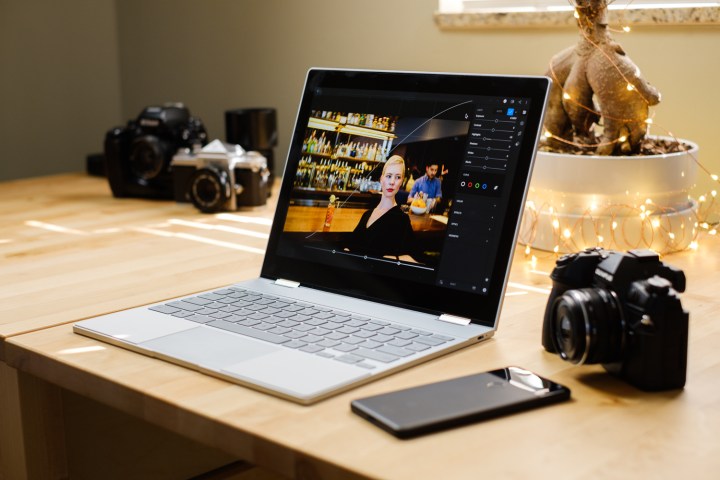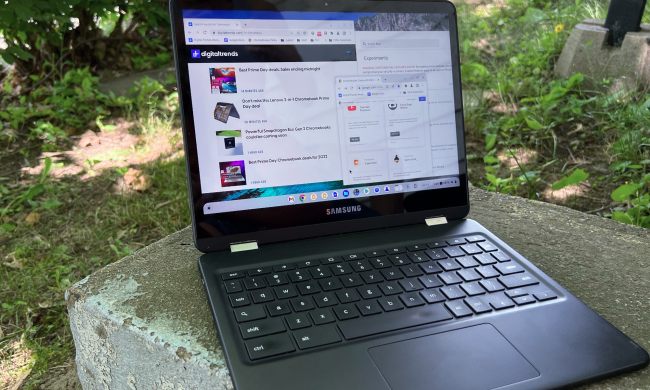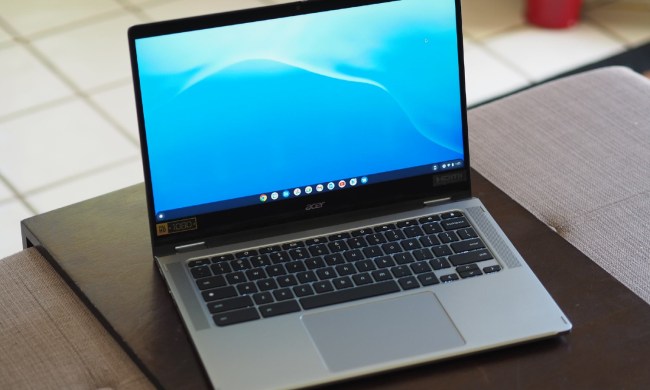
Historically, Chromebooks haven’t really targeted serious power users, but the $900 Google Pixelbook looked like it could change that perception when it came out last year. Beyond its high-class exterior, the Pixelbook can even be optioned with an Intel Core i7 processor (albeit, the mobile version) and 16GB of RAM. Clearly, this is meant for powering more than an operating system that started its life as little more than a glorified web browser.
The Pixelbook is a surprisingly capable photo editing machine.
Chrome OS, as far as it has come, is still a bottleneck in the overall experience — as our full Pixelbook review showed — but as more of what we do moves increasingly to the cloud, this has become less of a problem. The new Adobe Lightroom CC, for example, allows for RAW image editing on virtually any internet-connected device, from your desktop to your smartphone. And as Chrome OS matures, Adobe has even signed on to make bespoke versions of its creative apps for the Pixelbook.
All of this means the Pixelbook is a surprisingly capable photo-editing machine, but to answer the question of whether it can replace your MacBook Pro or Windows laptop, well, no — not exactly. Instead, the Pixelbook redefines the post-production experience, offering a hybrid blend of tablet and desktop editing that will feel right at home to people young enough to have grown up with a smartphone in their pocket, but will feel very unfamiliar to photographers who remember when a cloud was simply a puffy white thing in the sky.
Android: The Pixelbook’s secret weapon
The Pixelbook hardware is stunning to look at. The screen is gorgeous, and the 3:2 aspect ratio is perfect for photography. The display is very glossy and reflective, which isn’t exactly great for photo editing, but is pretty much par for the course today. For this article, Google provided us with the midrange Core i5 model with 8GB of RAM and a 256GB solid state drive ($1,099). Opting for the Core i7 pushes that up to $1,549, but you also get double the memory and storage space — although, we’re not sure if a 512GB drive would be necessary on a Chromebook.

One of the cleverer aspects of the Pixelbook is that it can run standard Android apps right off the Google Play store. While the experience won’t be as refined as that for Pixelbook-specific apps, like Lightroom, it opens up some opportunities for photographers that other laptops don’t have. If you have a Wi-Fi-enabled camera, you can install your camera manufacturer’s remote control app right onto the Pixelbook and control your camera from it, just as you would from your phone.
You can share images mages straight to Instagram from the Pixelbook.
This also lets you wirelessly transfer images from your camera to the Pixelbook, which could be great, but in reality it’s just shy of pointless. Most camera apps will only transfer JPEGs, so if you want to edit the original RAW, you’ll need another solution. What’s more, this is somewhat of a slow and clunky process — a simple SD card slot (which the Pixelbook lacks) would have been much more convenient.
Fortunately, the Pixelbook does at least have two USB Type C ports, so you can plug in your camera directly to transfer files, even when charging the Pixelbook at the same time. (If your camera supports USB charging, you’ll also charge your camera).
Being able to install Android apps also means you can load Instagram. Within Lightroom, as it is technically the mobile version of the app, you now have the option to share images straight to Instagram from the Pixelbook, something you can’t do from a MacOS or Windows laptop. If you’re an Instagram power user, this is a pretty great trick — typing out photo descriptions and hashtags on a keyboard might save you a lot of time.
Touch, don’t click
The Pixelbook’s specs may be all laptop, but trying to use it the way you would any other laptop for photo editing is an exercise in futility. Part of this is simply due to the fact that the Pixelbook version of Lightroom isn’t built like a desktop app. Its interface more closely resembles the mobile version, and there are no keyboard shortcuts, so even navigating the interface is much slower.

However, this all goes away the minute you remember the Pixelbook’s screen can be flipped over and put into tablet mode. Suddenly, you’ll be powering through edits in no time. If you haven’t used Lightroom on a tablet before, it takes surprisingly little time to pick it up. Really, it’s the most natural-feeling way to interact with your photos.
We did have some occasional issues. Adjustment sliders didn’t always respond to touch input on the first try, for example, and we’re not sure if this the fault of the hardware or the software. (We had a similar issue when trying to click-and-drag with the trackpad, so this may be a bug in Lightroom.) Exporting images to the Pixelbook’s internal drive also led to the strange problem of not being able to delete those files later, due to an apparent permissions issue.
The Pixelbook isn’t a revolutionary new device, but it shows how the standards of postproduction are evolving.
There are two larger concerns about this entire paradigm, however. First, while retouching photos by touch feels very natural, it also means you end up with fingerprints all over the screen which, like reflections, can be a big distraction. Second, it begs the question: If you’re going to use the Pixelbook as a tablet, why not just buy a tablet? Even the 12.5-inch iPad Pro starts at just $799 and weighs nearly a pound less than the Pixelbook — and it runs Lightroom very well.
The Pixelbook, then, is the single-product solution for someone who wants both a tablet and a laptop, but can afford only one. And like other hybrid solutions, it’s not the best in either role. If you want desktop photo editing with tablet convenience for travel and entertainment, it’s not for you. If, instead, you enjoy editing photos by touch — perhaps you currently work often from your phone — but you also need a computer that lets you hammer out the occasional Google doc or spreadsheet, then the Pixelbook might be just what you’re looking for.
We wouldn’t call the Pixelbook a revolutionary new device for photography, but it is an example of how the standards of postproduction are evolving. For a new generation of photographers, the idea of a desktop-based editing workflow is a foreign concept. Working by touch and letting the cloud manage your files can be quite freeing, even if it may take a while for some of us old-schoolers to wrap our heads around it.



